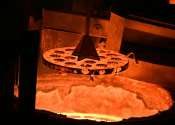Pilot plant demonstrates iron-based hydrogen storage feasibility
Photovoltaics are set to meet over 40% of Switzerland's electricity needs by 2050. But solar power isn't always available when it's needed: there's too much of it in summer and too little in winter, when the sun shines less ...
8 hours ago
0
7









